


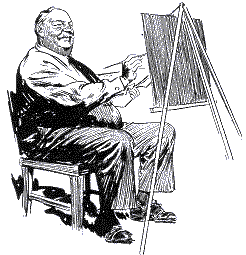
|

|
See issue 12 for four sensational color plates #2 has his art, too. |

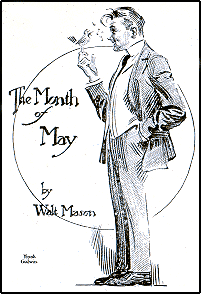 Born in Washington
DC in 1889, Godwin was the son of the city editor of The Washington
Star. Self-taught, he began his career as an apprentice on
that newspaper. A stint at the Art Students League
brought him in contact with James Montgomery Flagg and, by 1908, his work
began to appear in humor magazines of the day. By 1915, he was
firmly established at Judge doing headings for stories
(at right), and even the title page drawing for their annual reprint
collection (at left).
Born in Washington
DC in 1889, Godwin was the son of the city editor of The Washington
Star. Self-taught, he began his career as an apprentice on
that newspaper. A stint at the Art Students League
brought him in contact with James Montgomery Flagg and, by 1908, his work
began to appear in humor magazines of the day. By 1915, he was
firmly established at Judge doing headings for stories
(at right), and even the title page drawing for their annual reprint
collection (at left).
While obviously influenced by Flagg (and Charles Dana Gibson), Godwin managed to create a style that was recognizably his and that stood out from both his idols and the mass of clones that were cropping up everywhere. His ability to create tones, especially facial characteristics, with his pen and brush were equal to and in some ways better than Gibson and, I think, obviously superior to Flagg. His use of pen and brush in the same illustration demonstrated an understanding of the medium that set his work apart from his contemporaries. It, combined with his tonal skills, gave his work a depth and weight that was seldom equaled. Walt and Roger Reed in The Illustrator in America 1880-1980 credit some of this realism to his modeling of busts in clay for reference. They don't say when he adopted this practice, but it's unlikely that he was doing this so early in his career.
 By 1920, his pen work could be found in advertisements as well. By 1925 he was doing painted covers for magazines like Liberty, also in a style influenced by Flagg. He had already progressed beyond his mentor and some of the covers may well be direct homages done for commercial salability. Other influences and markets had opened up to Godwin. |
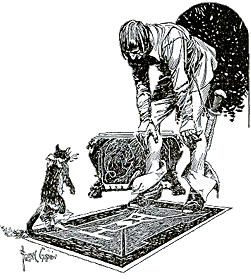 In 1921, publisher David McKay commissioned him to illustrate an edition of The Blue Fairy Book by Andrew Lang. With color and sumptuous pen and ink plates, Godwin demonstrated a broad talent and a wide range of influences. Parrish and Wyeth come immediately to mind on the color plates (above left), but the only similarity I can conjure for the pen and ink work is Orson Lowell (see Puss in Boots above). |
 Also from McKay during this period were editions of Robin Hood (nd above) and The Black Arrow (1923) - both featuring wonderful suites of color plates that announced Godwin as one of the premier adventure illustrators of the day. Unfortunately, the day of the adventure book illustrator was almost over. |

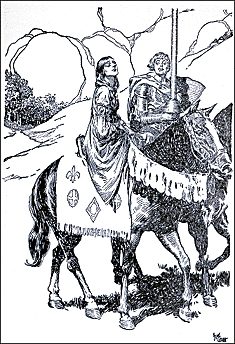 Before it
faded away, however, John C. Winston, the book publisher, started
a series of classic adventure stories, much in the manner of the
Scribner Classics. Godwin was selected to provide both painted
and penned illustrations for several of them. In 1924, he worked
on Tales from Shakespeare and Treasure Island. 1925
brought Kidnapped and Robinson Crusoe. Can you say
N.C. Wyeth boys and girls? All the while he was also working in
the major magazines of the day, but his pen and ink style was
no longer as much in demand. In 1927 he developed a new outlet
for his drawings, the newspaper strip, Connie. More on
the strip in a bit. Also in 1927, he provided illustrations for
Winston's King Arthur and his Knights and The Ten Dreams
of Zach Peters (also known as The Road to Liberty).
Before it
faded away, however, John C. Winston, the book publisher, started
a series of classic adventure stories, much in the manner of the
Scribner Classics. Godwin was selected to provide both painted
and penned illustrations for several of them. In 1924, he worked
on Tales from Shakespeare and Treasure Island. 1925
brought Kidnapped and Robinson Crusoe. Can you say
N.C. Wyeth boys and girls? All the while he was also working in
the major magazines of the day, but his pen and ink style was
no longer as much in demand. In 1927 he developed a new outlet
for his drawings, the newspaper strip, Connie. More on
the strip in a bit. Also in 1927, he provided illustrations for
Winston's King Arthur and his Knights and The Ten Dreams
of Zach Peters (also known as The Road to Liberty).
It was King Arthur, with it's strong Wyeth feel to the color plates that also brought with it a precursor of its own. This image (above right) could very easily have influenced Hal Foster, whose Prince Valiant, was still a decade in the future. The subject matter, of course, provides some inherent similarities, but the line-work and that classic approach are also shared characteristics. (For some odd reason, two of the plates in King Arthur are by another artist, marring an otherwise excellent book.
Two more Winston titles followed in 1929, The Swiss Family Robinson and The Book of Courage, but then the market and editorial tastes changed. After that, with only occasional forays into the magazines like Collier's, all of Godwin's work was created for that remaining bastion of the pen, the newspaper comic strip. Working for the small Ledger Syndicate, Godwin created Connie and served as a ghost cartoonist for many of the syndicate's even lesser-known other offerings. Some of these include: Eagle Scout and War on Crime.
Connie, which ran from 1927 to 1944, was an anomaly among newspaper strips. Initially the heroine could have been any of a dozen young girls living at home and deriving a daily dose of light comedy from her interactions with suitors and swains. Maurice Horn, in The World Encyclopedia of Comics, says: "Then came the Depression and Connie turned out to be a girl with a social conscience; she helped her mother with her charity work and often visited the men on the bread lines (one of the very few instances where the Depression was graphically depicted in a comic strip). ... In 1934 Connie went to work, first as a reporter, then as the operator of a detective agency (a kind of female Sam Spade)." She flew airplanes, starred in a motion picture and even went, eventually, on an interplanetary tour to explore the solar system. Again, Mr. Horn: "Connie is a liberated woman: intelligent, self-reliant, at ease in all situations. Holding her own against any man, she would certainly have made a better representative for the women's movement than ... Wonder Woman." The image below is part of a Sunday page from 1940 that was offered for sale in Russ Cochran's Graphic Gallery #5 in 1975.
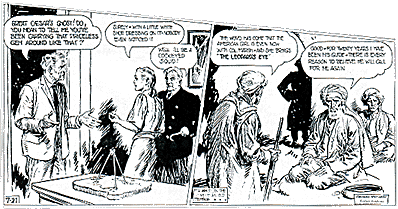
After Connie's 17-year run, Godwin's work could be found in the other refuge for old penmen, the comic book. He drew Wonder Woman for National Comics in 1943 and sporadic stories for Lev Gleason, the prime crime comic publisher, from 1945-1948. By 1948 he was ready to tackle the newspaper strip market with Rusty Riley. King Features distributed this story of an orphaned runaway boy, his dog, and the wealthy patron who befriends him. Can you say Little Orphan Annie? Actually, the mix included horse racing, crime detection and budding romance, most of which were never prime components of Gray's strip.
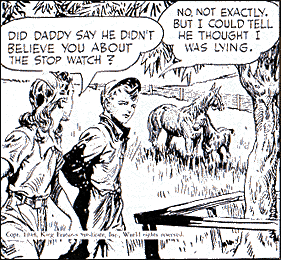 And
the art! Oh the art! Done primarily with a brush, and with 40
years of experience behind him, Godwin's art overcame the tepid
scripts he was given and populated the space with lush foliage,
recognizable characters, realistic animals and a strong sense
of place and time. And he wasn't afraid to use the panel to its
fullest. The image at left is from an early (1948) strip and is
taken from issue #9 of Russ Cochran's Graphic Gallery.
The lament of modern comic strip artists is that there is no space
to really draw, because the reproduction size is so small. Cochran
reproduced the Rusty Riley strip directly above a modern
Broom Hilda sample, both at the same size, 7"x2".
This is very close to modern strip size in newspapers (perhaps
6 1/2" x 1 7/8") and I can't find a serious spatial
constraint that keeps Russell Myers, or any other modern cartoonist,
from the same graphic richness that Godwin shows. Yet we never
see the detail and effort that is evident in Rusty Riley
and many other strips of the day. Perhaps there are other factors
impinging on the modern artist of which I'm unaware, but I can't
think of any.
And
the art! Oh the art! Done primarily with a brush, and with 40
years of experience behind him, Godwin's art overcame the tepid
scripts he was given and populated the space with lush foliage,
recognizable characters, realistic animals and a strong sense
of place and time. And he wasn't afraid to use the panel to its
fullest. The image at left is from an early (1948) strip and is
taken from issue #9 of Russ Cochran's Graphic Gallery.
The lament of modern comic strip artists is that there is no space
to really draw, because the reproduction size is so small. Cochran
reproduced the Rusty Riley strip directly above a modern
Broom Hilda sample, both at the same size, 7"x2".
This is very close to modern strip size in newspapers (perhaps
6 1/2" x 1 7/8") and I can't find a serious spatial
constraint that keeps Russell Myers, or any other modern cartoonist,
from the same graphic richness that Godwin shows. Yet we never
see the detail and effort that is evident in Rusty Riley
and many other strips of the day. Perhaps there are other factors
impinging on the modern artist of which I'm unaware, but I can't
think of any.
Rusty Riley was canceled in 1959 and Godwin died just
a few weeks later. He was one of the last survivors of that turn-of-the-century
breed of artists who could perform miracles with a brush and ink.
As they grew older and died, so did the market for their skills.
There is a small cadre of modern artists who were inspired by
that era and look to the same sources for inspiration, but I don't
see a new generation preparing to take their place. Godwin's
place in illustration is well secured, but his place as one of
the premier penmen of the century has yet to be declared. Anybody
want to second the motion?
 You can find out more about Frank Godwin in the following
books:
You can find out more about Frank Godwin in the following
books:
| The World Encyclopedia of Comics | Maurice Horn, 1976 Chelsea House |
| The Illustrator in America 1880 to 1980 | Walt and Roger Reed, 1984 Madison Square Press |
| 200 Years of American Illustration | Henry Pitz, 1977 Random House |
| The Vadeboncoeur Collection of Knowledge | Jim Vadeboncoeur, Jr. |
| The Vadeboncoeur Collection of ImageS 12, B&W ImageS 2 | Jim Vadeboncoeur, Jr. 2004, 2010, JVJ Publishing |
|
Illustrations are copyright by their
respective owners. This page written, designed & © 1998 by Jim Vadeboncoeur, Jr. Updated 2011. |
